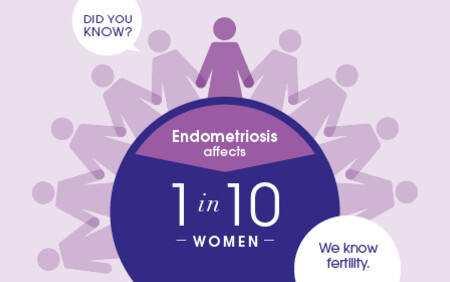
Endometriosis and fertility
It’s not all bad news when it comes to endometriosis – and the good news is there’s a lot we can do about it.
At a glance
- Endometriosis affects one in 10 Aussie women
- It’s not uncommon for people suffering from endometriosis to struggle with conceiving naturally
- Endo-induced infertility can be treated with surgery, or helped along with fertility treatments such as IVF
Endometriosis is a common condition that affects one in 10 Australian women, where the tissue that’s similar to the lining of the uterus – the endometrium – grows outside of the uterus.
During ovulation this lining bleeds, causing inflammation and discomfort along with a build-up of scar tissue that may affect a woman’s fertility and bring on extremely painful periods.
“It’s a very uncomfortable condition,” says Queensland-based fertility specialist Dr David Molloy. “However we need to be careful, as the severity doesn’t always correspond with the symptoms of patients.”
According to Dr Molloy, more pain doesn’t necessarily equal a higher-grade diagnosis – or increased risk of affected fertility – which is why seeing a doctor is so pivotal in creating an individualised treatment plan that will work for you.

So, what are the symptoms?
With painful cycles often seen as a signature symptom, Dr Molloy emphasises that it’s more specifically period pain that gets worse over time. “Pain you’ve had since you were a kid is less likely to be the disease,” he says.
Typical complaints of endometriosis sufferers include:
- painful periods
- pain during intercourse
- pelvic discomfort
- ovulation pain
- lower back pain
- pain when emptying bowels
- pain when passing urine
- nausea and exhaustion
- premenstrual symptoms
Decreased fertility is also of concern to many people with endometriosis, with 50 per cent of women experiencing a significant delay when attempting to conceive. But don’t worry, because there’s plenty we can do about it.
Endometriosis and getting pregnant
Even though the journey to conceive may be a little lengthier for women with an endometriosis diagnosis, with the right treatment many go on to have healthy, viable pregnancies.
“Success definitely depends on the severity of the endometriosis,” explains Dr Molloy. “If it’s so severe that it’s damaged the pelvis and scarred the ovaries then almost all of those patients will need the IVF program to get pregnant,” he adds.
However if pregnancy isn’t a concern right now – but perhaps later down the track – medication to temporarily suppress menstruation can be prescribed. “No periods, no pain,” explains Dr Molloy, who cites the contraceptive pill as a common solution.
Future talk
While it may seem like endometriosis is on the rise, Dr Molloy insists that it’s just the rates of diagnosis – which is a good thing. “We can diagnose it a lot sooner now, and can immediately recognise the family history,” he says.
And it’s not all doom and gloom either. “Having endometriosis is definitely not the end of the world, but missing it might be,” he says.
If you have unexplained infertility associated with painful periods and mid-cycle discomfort, chat to your GP or fertility specialist about whether this common condition might be to blame.
Sources
https://www.ivf.com.au/about-fertility/female-reproductive-system/endometriosis
